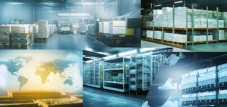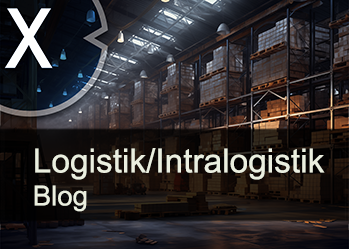When steel meets ice: Heavy-duty logistics and cold-weather logistics – Why this unlikely logistics pair secures our future
Xpert pre-release
Language selection 📢
Published on: November 26, 2025 / Updated on: November 26, 2025 – Author: Konrad Wolfenstein

When steel meets ice: Heavy-duty logistics and refrigerated logistics – Why this unlikely logistics pair secures our future – Creative image: Xpert.Digital
When precision meets power: Synergies in modern logistics – The invisible connection in the transport world
Specialized logistics: Logistics in transition – Why heavy haulage and the cold chain now need to be considered together
At first glance, they seem like oil and water: heavy-load logistics, which maneuvers gigantic wind turbines through narrow passages with brute force, and refrigerated logistics, which protects the most sensitive pharmaceuticals from spoilage with surgical precision. But appearances are deceiving. A deeper analysis reveals that these two extremes of the transport industry not only face the same existential challenges, but together form the backbone of modern Industry 4.0.
In a world where global economic growth depends on niche markets, two giants are coming into focus, giants that could hardly be more different. While the market for oversized cargo is inexorably heading towards the $200 billion mark, the demand for highly complex cold chains is exploding in parallel – driven by a changing healthcare industry and global consumer demands. But beyond the impressive revenue figures, both sectors are united by an invisible bond of “zero tolerance”: A steering error with an 80-meter rotor blade is just as fatal as a minimal temperature fluctuation with an mRNA vaccine.
Suitable for:
Markets worth billions: Double boom in specialized logistics
On the surface, the modern logistics landscape appears to be a universe of strictly separated specializations. On the one hand, there's heavy-lift logistics, which maneuvers turbines, wind turbine blades, and transformers through narrow towns with brute force; on the other, there's cold chain logistics, which monitors temperatures of minus 70 degrees Celsius with surgical precision to ensure that sensitive vaccines or fresh food reach their destination undamaged. These two segments could hardly be more different, yet closer inspection reveals a fascinating convergence that is revolutionizing our entire understanding of modern transport services.
The global market for transporting oversized cargo reached a volume of US$201.02 billion in 2024 and is projected to continue growing at an annual growth rate of 4.58 percent until 2033. In parallel, cold chain logistics is experiencing even more dynamic growth, with a global market value of US$341 billion in 2024 and a projected annual growth rate of 15.3 percent between 2025 and 2034. The German market for cold chain logistics alone is estimated at US$16.92 billion in 2024 and is expected to grow to US$25.44 billion by 2029. These figures illustrate not only the immense economic importance of both segments but also the need to identify and leverage synergies between seemingly incompatible logistics disciplines.
Another link between these and other specialized areas is heavy-duty warehouse logistics. This involves not just the simple storage of containers or industrial equipment, but highly precisely coordinated processes: from the use of heavy-duty racking with load capacities in the double-digit ton range, to modular container storage areas, and automated crane and conveyor systems that enable positioning accurate to the millimeter. In port and industrial areas, transport and warehouse logistics are increasingly merging into integrated hubs where transshipment, temporary storage, and onward distribution are organized in a single logistical flow. Digitalization – for example, through IoT-based condition monitoring systems for stored containers – is becoming increasingly important in this context, ensuring safety, efficiency, and real-time transparency.
The hidden kinship of extreme demands
Looking at the operational challenges of both logistics sectors reveals striking parallels that go far beyond superficial similarities. Both heavy haulage and cold chain logistics operate in an environment where even the slightest deviations from predefined parameters can lead to catastrophic consequences. In heavy transport, a steering angle of just a few degrees can determine whether an 80-meter-long rotor blade can be safely maneuvered past lampposts, building facades, and embankments. In cold chain logistics, a temperature deviation of only a few degrees can mean the loss of an entire vaccine shipment, as the global distribution of the COVID-19 vaccine so vividly demonstrated.
The logistical challenge of distributing the mRNA vaccines against COVID-19 presented the entire industry with unprecedented tasks. The BioNTech and Pfizer vaccine required storage at a constant minus 70 degrees Celsius, while the Moderna vaccine needed temperatures between minus 25 and minus 15 degrees Celsius. These extreme demands on the cold chain made the COVID-19 vaccination the largest humanitarian logistics operation ever undertaken worldwide and simultaneously revealed the critical importance of precise temperature control for public health. The parallel to heavy-load logistics lies in the absolute zero tolerance for errors: both a damaged transformer and a vaccine rendered unusable by temperature deviation mean not only financial losses but potentially far-reaching societal consequences.
Infrastructural challenges as a unifying element
German infrastructure presents both logistics segments with identical structural problems, making a comprehensive analysis unavoidable. Dilapidated bridges force heavy transport vehicles to take costly detours, causing billions of euros in damage to the German economy. The Rahmedetal Bridge near Lüdenscheid illustrates the scale of the problem. Companies like Liebherr in Ehingen an der Donau have to accept detours of more than 1,000 kilometers to transport their cranes, which weigh over 100 tons, because numerous bridges no longer have the required load-bearing capacity. Nearly 1,000 bridges in North Rhine-Westphalia alone are so dilapidated that they can no longer be used by heavier trucks.
This infrastructure problem, however, is by no means limited to heavy haulage logistics. Cold chain logistics also relies on a functioning road infrastructure, as the distribution of temperature-sensitive goods in Europe is primarily by road. The continent's high population density and the need for careful control of storage conditions during transport make road transport the preferred mode of transport. Longer transport times due to detours can be just as critical for perishable goods as for time-critical heavy haulage, because every additional hour in transport increases the risk of a break in the cold chain.
Technological convergence through digitization
The digital transformation of the logistics industry is driving both segments toward a shared future. The Internet of Things (IoT) enables real-time monitoring in both sectors, something that would have been unthinkable just a few years ago. GPS trackers monitor heavy transport vehicles in real time, allowing for precise route optimization, while IoT sensors in refrigerated logistics continuously monitor temperature and humidity, triggering immediate alerts in case of deviations. The integration of artificial intelligence promises significant efficiency gains for both industries: real-time tracking systems reduce delivery delays by an average of 25 percent through proactive problem detection.
The combination of IoT, AI, and blockchain technology is revolutionizing the entire logistics industry, enabling real-time tracking and monitoring of goods, optimized routes, and secure, transparent transactions. For heavy-duty logistics, this means more precise planning of permit processes and routes, while refrigerated logistics benefits from seamless documentation of temperature profiles, which is essential for regulatory compliance. Both industries thus share not only similar technological solutions but also the fundamental need for transparency and traceability throughout the entire supply chain.
The regulatory jungle as a shared challenge
The permitting processes for oversized and heavy transport are considered a prime example of excessive bureaucracy in Germany. Regulations between the federal government, states, and municipalities are fragmented and highly complex, significantly hindering the implementation of important infrastructure and industrial projects. Transporting all the components of a wind turbine requires between 60 and 80 heavy transports, each needing its own permit. For the planned expansion of onshore wind energy, up to 60,000 heavy transports per year are projected in Germany alone starting in 2025.
Cold chain logistics faces similar regulatory challenges, although these are of a different nature. In Germany, there are currently over 700 food-related regulations governing food storage. Food law is determined not only by federal and state laws and ordinances, but also by numerous European Union regulations. Regulations concerning food hygiene, hygiene standards for animal-based foods, and temperature monitoring of frozen foods in transport vehicles represent only a fraction of the regulatory framework. Pharmaceutical cold chain logistics is additionally subject to the EU's Good Distribution Practice (GDP) requirements, which prescribe precise temperature ranges of +2 to +8 degrees Celsius or +15 to +25 degrees Celsius.
The shortage of skilled workers as a cross-industry phenomenon
The German logistics industry is grappling with a dramatic shortage of skilled workers, affecting both segments equally. The skills shortage reached record levels in 2025, with 85 percent of German employers struggling to fill vacancies. Road transport is particularly hard hit, where the driver shortage is estimated to be preventing growth for more than half of all European freight forwarding companies. Personnel costs will remain the biggest cost driver in the industry in 2025, and even a rising unemployment rate will not alleviate the significant effort required to find suitable workers and skilled professionals.
In heavy haulage logistics, the complexity of transport demands highly specialized personnel. Drivers maneuver their heavy-duty vehicles with millimeter precision and receive instructions via radio from escort teams who must monitor every movement. Refrigerated logistics, on the other hand, requires specialists with expertise in temperature monitoring, regulatory compliance, and handling sensitive goods. Regular staff training is essential to ensure that refrigerated goods reach their destination quickly and at the perfect temperature. This shared challenge of skilled labor shortages compels both sectors to adopt similar strategies for employee retention, training, and automation.
Specialized logistics – Europe's strength, expertise and market leadership
Cold storage and the storage of heavy loads – for example, in container high-bay warehouses – differ fundamentally from conventional warehousing models. These differences manifest themselves in almost every operational and infrastructural dimension, from construction costs to regulatory complexity.
The standard warehouse: The economical basic option
A conventional warehouse system represents the cost-effective standard. In warehouse construction, costs average between €700 and €1,100 net per square meter. The technical infrastructure is usually limited to basic electrical installations, and operations are carried out using standard storage and retrieval machines. A standard high-bay warehouse costs approximately €5,000 to €7,000 per unit to construct. Given that there are over 70,000 logistics service providers in Germany, this form of warehousing is widespread and operationally standardized.
Cold storage: High energy demand and strict regulations
In contrast, a cold storage facility is a highly complex, specialized property. Construction costs range from €2,600 to €3,700 per square meter – four to five times higher than the standard version. This is due to specialized insulation concepts and a sophisticated technical infrastructure: This includes multi-zone cooling systems, redundant refrigeration technology, humidification and dehumidification systems, and continuous monitoring systems for real-time temperature measurement.
From a business perspective, another factor dominates: energy consumption. A deep-freeze warehouse at minus 30 degrees Celsius generates cooling energy consumption that, even with optimal insulation, accounts for 30 to 40 percent of total operating costs. Added to this is an enormous regulatory burden with over 700 food law regulations, pharmaceutical GxP requirements, and certifications such as FSSC 22000. Warehouse management must also differentiate temperature zones, combine batch tracking with expiration dates, and fully document any deviations. Consequently, a storage space in a temperature-controlled high-bay warehouse costs two to three times as much as a standard one.
Bearings for heavy loads: Static precision and solid foundations
Heavy-duty container high-bay warehouses, for example, are subject to entirely different construction principles. With bay loads of up to 30 tons per bay, they require massive foundations and precise structural calculations according to DIN EN 15512. The costs per storage space unit here rise to between €8,000 and €15,000. The requirements for warehouse management are also critical: extremely precise storage location assignments are necessary, as incorrect placements can lead to catastrophic damage due to the enormous weights. From a regulatory perspective, specialized safety certificates and continuous verification of structural safety are paramount.
Market situation and competitive advantage
The integration of these two specialized systems represents a fundamental economic and strategic transformation. While the overall market is large, the actual heavy-lift logistics sector in Germany is operated by a few specialized companies, highlighting the high barriers to entry.
The combination of heavy-lift and refrigerated logistics expertise within a single company is a strategic rarity, as both segments require entirely different technological infrastructures, personnel qualifications, and investment models. This scarcity of true specialist providers makes the integration of both disciplines a critical competitive advantage and positions those few service providers who have developed this dual expertise as key strategic players in the modern European logistics landscape.
LTW Solutions
LTW offers its customers not individual components, but integrated complete solutions. Consulting, planning, mechanical and electrotechnical components, control and automation technology, as well as software and service – everything is networked and precisely coordinated.
In-house production of key components is particularly advantageous. This allows for optimal control of quality, supply chains, and interfaces.
LTW stands for reliability, transparency, and collaborative partnership. Loyalty and honesty are firmly anchored in the company's philosophy – a handshake still means something here.
Suitable for:
How digitalization unites heavy-duty and refrigerated logistics
Energy transition as a catalyst for convergence
The transformation of the energy system is acting as a powerful catalyst, increasingly blurring the lines between heavy-lift and refrigerated logistics. Transporting wind turbines presents immense challenges for heavy-lift logistics, as modern rotor blades reach lengths of 60 to 90 meters and weigh several dozen tons. The lowest tower segment of a wind turbine often weighs between 50 and 70 tons, the complete steel tower over 200 tons, and the hub, where the rotor blades connect, weighs around 20 tons. Up to 15 separate heavy transports are often required for a complete turbine: tower segments, nacelle, and multiple rotor blades must be coordinated and transported to the installation site.
At the same time, cold chain logistics is gaining importance in the context of the energy transition. The growth of electromobility requires temperature-controlled storage and transport of lithium-ion batteries, while hydrogen applications demand specialized cryogenic transport solutions. The overlaps become particularly clear when one considers that transformers and other electrical components for renewable energy plants also require precise temperature and humidity control during transport to prevent electrical damage. The energy transition thus creates a concrete use case where expertise in heavy-duty transport and cold chain logistics must converge.
Suitable for:
Diversification strategies of logistics service providers
Economic realities are increasingly forcing logistics service providers to diversify their service portfolios. A diversification strategy in transport logistics involves expanding the range of services, markets, or means of transport offered in order to reduce risks, improve competitive advantages, and increase profitability. In Germany, there are more than 70,000 logistics service providers, predominantly medium-sized companies, which are diversifying to remain competitive and offer their customers a broader range of services. In addition to traditional transport services, the expanded logistics portfolio includes value-added services such as packaging, assembly, contract logistics, e-commerce solutions, and after-sales services.
This development is leading to logistics providers with heavy-lift expertise increasingly incorporating temperature-controlled transport solutions into their portfolios, and vice versa. Specialized services such as cold chain logistics for pharmaceuticals or just-in-time delivery models for the manufacturing industry are offered as complementary services to the existing core business. Vertical integration through the expansion of the value chain, for example by building their own warehousing and distribution centers or acquiring other logistics providers, creates additional synergies between the specialized areas.
Common investment logic and capital commitment
Both heavy haul and refrigerated logistics are characterized by high capital intensity, making a strategic approach to investments essential. In heavy haul logistics, transport vehicles are often custom-built, as the machines have different dimensions and must be more powerful than standard vehicles. Additionally, escort vehicles and specialized cranes are frequently required, which significantly increases the start-up costs for companies in this segment. In Germany, there are fewer than 500 companies specializing in oversized and heavy transport, highlighting its niche nature and high barriers to entry.
Cold chain logistics also requires massive investments in specialized infrastructure. In 2024, there were 366 cold storage facilities in Germany with a total volume of approximately 24 million cubic meters and around 4.6 million Euro pallet spaces. Acquiring ultra-low temperature freezers for transport at minus 70 to minus 86 degrees Celsius, as required for mRNA vaccines, represents a significant investment. Refrigerated vehicles with integrated cooling systems that maintain controlled temperatures throughout the entire transport process incur considerably higher acquisition and operating costs than conventional means of transport. This parallel capital intensity creates economic incentives for cooperation and consolidation between the two segments.
The role of the platform economy
Digital platforms are transforming both logistics segments, creating new opportunities for networking and collaboration. Logistics platforms connect processes, goods, data, services, and people into a value creation network, offering companies access to a comprehensive range of services within and across markets. The logistics platform market has grown rapidly in recent years, with established logistics players as well as those without a traditional logistics background entering the market. The common goal of all logistics platforms is the integration of logistics stakeholders to increase transparency, cost efficiency, and resilience.
This platform development enables, for the first time, a systematic combination of expertise in heavy-lift and refrigerated logistics. Integration, transaction, and data-based services can be bundled via digital interfaces, giving companies access to an expanded range of services without having to invest in all specialized areas themselves. The visualization of business processes, individual states, and their deviations through visibility functions creates a common information base for all stakeholders. For clients with complex logistics requirements that include both heavy-lift components and temperature-sensitive goods, such platforms offer significant added value.
Sustainability as a unifying paradigm
The logistics industry's decarbonization goals are forcing both segments to fundamentally transform their operations. In heavy-duty logistics, alternative drive systems are being developed for particularly demanding transport tasks, where the sheer mass of goods being moved presents a particular challenge. A significant increase in electric trucks is expected by 2030, especially in urban areas, while hydrogen and synthetic fuels will see greater use in long-haul transport as infrastructure and costs improve.
Refrigerated logistics faces similar sustainability challenges, as maintaining temperature during transport and storage requires significant amounts of energy. Energy-efficient cold storage facilities and the use of electric vehicles for temperature-controlled transport contribute to reducing CO2 emissions. Automated loading systems in refrigerated and frozen food logistics can significantly reduce cold loss during the loading process, thus making an important contribution to sustainable energy management. Reducing loading times from an average of 30 minutes with conventional loading to just about 2 minutes with automated systems not only reduces energy losses but also operating costs.
Resilience through supply chain diversification
The experiences of recent crises have underscored the need for diversified and resilient supply chains. Supply chain diversification is understood as a proactive strategy that integrates various risk-mitigating dimensions into the supply chain network: multi-shoring, multi-sourcing, additional modes of transport, and diversification of logistics processes. According to a survey, more than half of the companies in Germany planned to adapt their supply chains, with almost two-thirds of respondents looking for new or additional suppliers and one-third planning to shorten or change transport routes.
These diversification strategies affect both logistics segments equally. Companies with heavy-load requirements need alternative transport routes and modes in case primary routes are blocked by infrastructure problems or other disruptions. Cold chain logistics requires redundant refrigeration capacity and alternative procurement channels for temperature-sensitive goods. The intelligent combination of both competencies in an integrated logistics network increases overall resilience and enables faster responses to unforeseen events.
Future scenarios of integrated logistics
The logistics industry is moving inexorably towards greater integration of specialized services. Three major trends are shaping the future of road freight transport: digitalization and artificial intelligence, sustainability, and collaboration. AI technologies are already in use at over 50 percent of logistics companies and will become significantly more important, with big data analytics optimizing routes through transport consolidation, minimizing empty runs, and supporting predictive vehicle maintenance. By 2030, artificial intelligence will be indispensable in the logistics industry.
For the convergence of heavy-duty and refrigerated logistics, this means that shared technological platforms will emerge, capable of serving both specializations. Self-driving vehicles, next-generation safety systems, quantum computers for complex optimization problems, and digital twins will shape the logistics industry over the next decade. Supergrid logistics, as a concept of modular services, promises greater efficiency through the flexible combination of various logistics services. 3D printing could shorten transport routes, increase the speed of the supply chain, and reduce warehousing costs, which is particularly relevant for spare parts in both logistics segments.
The macroeconomic dimension of industry symbiosis
The combination of heavy haulage and refrigerated logistics is of considerable economic importance to Germany as an industrial location. Heavy haulage logistics acts as a seismograph for overall economic development, because without functioning oversized and heavy transport, important construction projects, industrial ventures, and energy supply projects could not be implemented, or only with significant delays. Germany's competitiveness depends directly on a high-performance logistics infrastructure capable of reliably transporting both heavy industrial goods and temperature-sensitive products.
Despite economic challenges, the German logistics market as a whole is experiencing stable growth. The logistics indicator of the German Logistics Association (BVL) shows a slight upward trend in the business climate, with business expectations steadily improving throughout the year. The European logistics market reached a value of US$288.99 billion in 2024 and is projected to grow at an annual rate of 6.6 percent until 2033. Road transport dominates the European logistics market with a share of 60.4 percent in 2024.
Strategic implications for corporate decisions
The analyzed convergence offers concrete strategic options for logistics service providers and their clients. Specializing in a single logistics segment carries increasing risks in a market environment characterized by volatility and uncertainty. Diversification, or diversification in the business sense, means expanding a company's service portfolio beyond its core business with the aim of achieving growth or minimizing risks. Systematically expanding heavy-lift capabilities to include refrigerated logistics, or vice versa, creates synergies through the shared use of infrastructure, technologies, and human resources.
Cost savings result from combining resources such as personnel, warehousing, and logistics. For example, the same locations can be used for various logistics services, instead of maintaining separate facilities for each business unit. Increased efficiency stems from synergies that make processes faster and smoother, thereby improving the company's overall performance. For clients, collaborating with integrated logistics providers means reduced complexity in supplier management and greater flexibility in responding to changing requirements.
The strategic symbiosis of two contrasting logistics worlds
The initial question of how heavy-lift logistics and refrigerated logistics, as seemingly disparate sectors, can coexist, is answered by a multifaceted analysis that goes far beyond superficial observations. The apparent opposition between these two logistics segments, upon closer examination, reveals itself to be a complementary relationship in which shared challenges, technological developments, and economic conditions are leading to increasing convergence. Both sectors operate at the extremes of logistical demands, both require the highest precision and reliability, both grapple with infrastructural deficiencies and regulatory complexity, and both benefit from the digital transformation of the logistics industry.
The energy transition as a driver of change, the shortage of skilled workers as a shared challenge, the platform economy as a unifying technological paradigm, and sustainability requirements as a societal imperative create a context in which the integration of heavy-lift and refrigerated logistics expertise is not only sensible but increasingly necessary. The most successful logistics service providers of the future will be those who recognize and strategically leverage this seemingly paradoxical symbiosis. Ultimately, both sectors share a fundamental characteristic: the absolute necessity of having the right thing in the right place at the right time, regardless of whether it's a 100-ton transformer or a temperature-sensitive vaccine vial.

Xpert.Plus warehouse optimization - high-bay warehouses such as pallet warehouses consulting and planning
We are there for you - advice - planning - implementation - project management
☑️ Our business language is English or German
☑️ NEW: Correspondence in your national language!
I would be happy to serve you and my team as a personal advisor.
You can contact me by filling out the contact form or simply call me on +49 89 89 674 804 (Munich) . My email address is: wolfenstein ∂ xpert.digital
I'm looking forward to our joint project.

























